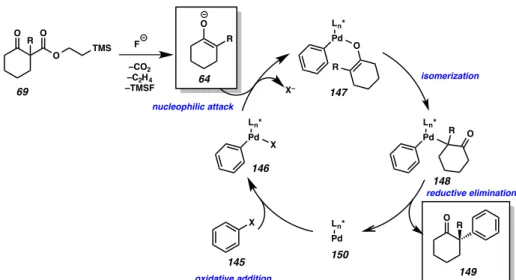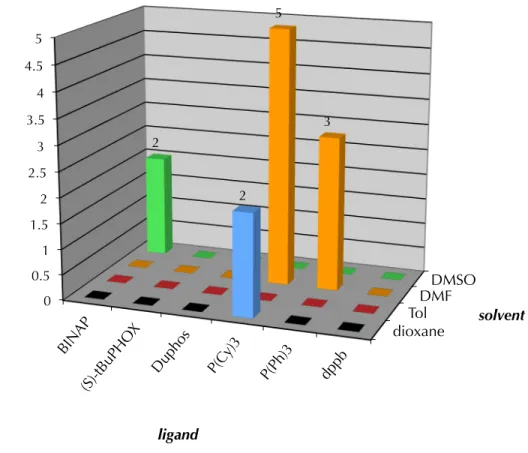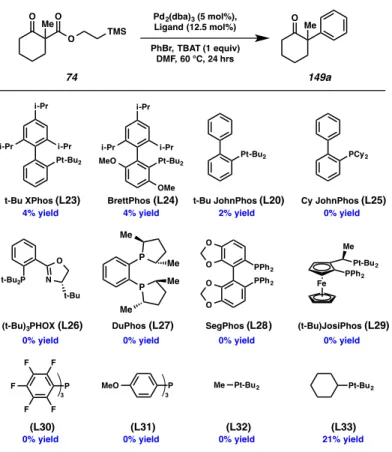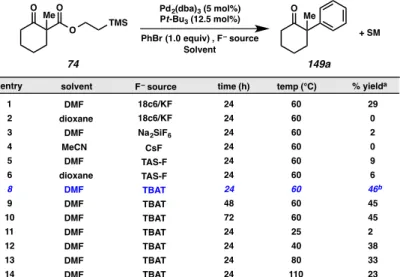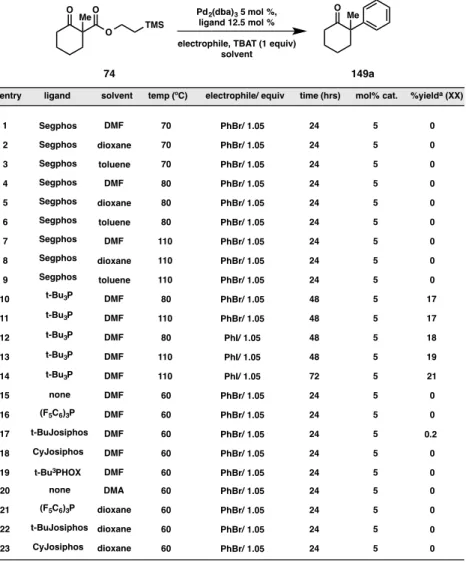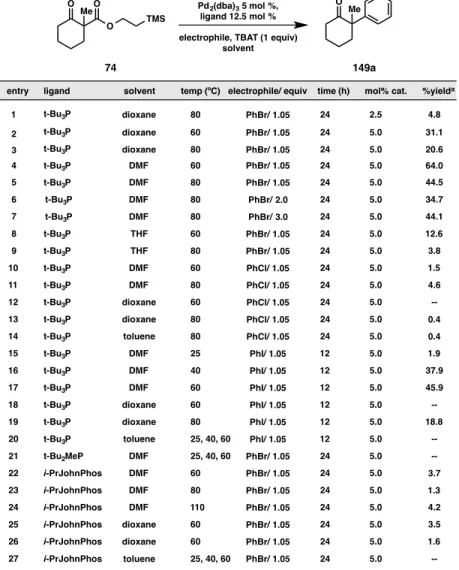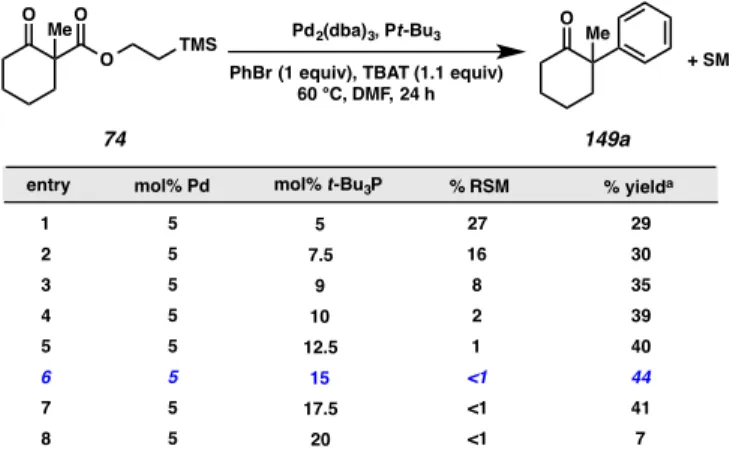APPENDIX 8
Development of an
α
-Arylation Reaction of TMSEβ
-KetoestersA8.1 INTRODUCTION
A8.1.1 Background and state of the art in the α-arylation of cyclic ketones
The ubiquity of all-carbon quaternary stereocenters in natural products and other compounds that possess antibiotic, antimicrobial, antifungal, anti-tumor and other therapeutic properties provides a strong impetus for researchers to continue to seek out new methods for the construction of this important motif.106 Within this domain, benzylic quaternary ketones have received a significant amount of attention, owing in part to the presence of an excellent functional group handle (i.e. the carbonyl) as well as the prevalence of arylated quaternary centers in medicinally important compounds107 (Figure A8.1.1).
Figure A8.1.1.1. Natural products containing benzylic quaternary stereocenters
NMe H HO
HO
O H
morphine
NMe O
OMe OMe
(–)-mesenbrine
NMe
CO2Me N
H N OH
HO MeO2C AcO
Me HN
Me
vinblastine
MeO OMe
MeN
OMe OMe NC
Me Me
verpamil
128 129 130 131
The development of methods for the preparation of arylated quaternary centers via the α-arylation of nonstabilized ketones has been a subject of intense research for the past two decades.108 Early reports of transition-metal catalysis in this reaction focused on the use of palladium catalysts bound by sterically encumbered, electron-rich phosphine ligands. A milestone publication by Buchwald109 and coworkers demonstrated that Pd2(dba)3, bound with p-tol-Binap (L18) as ligand, serves as an efficient catalyst for the direct arylation of ketone enolates (Scheme A8.1.1.1A). Concurrent this to publication, Hartwig 110 disclosed a report describing the use of a 1,1′-Bis(di-o- tolylphosphino)ferrocene (L19, DTPF)/Pd2(dba)3 catalyst system for α-arylation that capably provided α-arylated α-quaternary ketones (Scheme A8.1.1.1B). These two publications represent the first examples of direct catalytic α-arylations of nonstabilized ketones.
Scheme A8.1.1.1. Initial Reports of Direct α-Arylation of Ketones by Buchwald (A) and Hartwig (B)
O Ph
PhBr (0.95 equiv), Pd2(dba)3 (10 mol%) L19 (15 mol%), KN(SiMe3)2 (1.2 equiv)
refluxing THF 55% yield
O
Ph Fe
P(o-tol)2
P(o-tol)2 DTPF B.
A. O (4-t-Bu)PhBr (0.5 equiv), Pd2(dba)3 (1.5 mol%) Tol-Binap (3.6 mol%), NaOt-Bu (1.3 equiv)
refluxing THF 83% yield
O t-Bu
P(p-tol)2 P(p-tol)2
59
133 134
132 L18 tol-binap
L19
Ensuing reports from a number of research groups, following these initial communications, revealed the superiority of extremely sterically bulky phosphine ligands in the formation of quaternary centers via this transformation.111 The Hartwig and Buchwald groups have remained at the forefront of these developments. The reported improvements to their respective catalytic systems constitute the most successful α- arylation of nonstabilized enolates in the absence of blocking groups to date (Scheme A8.1.1.2, A112 and B113).
Scheme A8.1.1.2. Improved Catalyst Systems for α-Arylation by Hartwig (A) and Buchwald (B)
A8.1.2 State of the art in the asymmetric α-arylation of cyclic ketones
The current state of the art in the catalytic asymmetric α-arylation of ketones to form all–carbon quaternary centers is exemplified, again, by the research efforts of the Hartwig and Buchwald groups. Studies by Buchwald and co-workers have focused on the use of α’ blocked α-methylcyclopentanone derivatives (136) as substrates (Scheme A8.1.2.1A).114 Sterically encumbered mono-phosphine ligand (L20) has been shown to efficiently catalyze the transformation (Scheme A8.1.2.1A) in good yields and excellent
O Ph
PhBr (0.90 equiv), Pd(OAc)2 (1 mol%) P(t-Bu)3 (1.25 mol%), NaOt-Bu (1.5 equiv)
THF, 50 °C 92% yield
O Ph A.
O Ph
O Ph B. (4-OMe)PhBr (0.83 equiv), Pd(OAc)2 (1.0 mol%)
L20 (2.0 mol%), NaOt-Bu (1.3 equiv) toluene, 80 °C
72% yield
P(t-Bu)2
OMe L20X JohnPhos
133
133 135
134
enantiomeric excess. Unfortunately, the tolerance of the transformation to substrate variability has been highly limited and even seemingly innocuous adjustments to the substrate, such as employing the corresponding 6-membered α’-blocked α- methylcyclohexanone derivative, results in substantially diminished selectivity with ee’s no higher than 70%. All attempts by Buchwald and coworkers, thus far, to generalize this reaction have proven nonviable.
Hartwig and co-workers obviated the need for an α’-blocking group by focusing their studies exclusively on substrates which inherently lack more than one enolizable proton, namely tetralone and indanone derivatives (138). Their work has shown that the use of chiral phosphine difluorphos (L22) under palladium catalysis is highly effective in promoting the α-arylation of tetralone and indanone substrates, delivering the corresponding α-quaternary ketone products (139) in moderate to excellent yields and uniformly excellent ee’s (Scheme A8.1.2.1B). More recently, Hartwig and co-workers have also shown pre-formed nickel complex [((R)-BINAP)Ni(η2-NC-Ph)] to be an effective metal source for the heteroarylation of tetralone and indanone substrates (Scheme A8.1.2.1C).
Scheme A8.1.2.1. Current State of the Art in Catalytic Asymmetric α-Arylation to Form α- Quaternary Ketones
Although existing asymmetric α-arylation methods are outstanding, considerable deficiency remains in the scope of compatible substrates. Indeed, catalytic asymmetric means to access the deceptively simple looking 2-alkyl-2-arylcyclohexanone (149) shown in Figure A8.2.2.1 (R = alkyl) are not known. We believe that the use of prochiral enolates generated in situ, in the absence of exogenous base will be crucial in identifying a solution to this problem.
A8.2 BACKGROUND: EXTENSION OF CARBOXYLATE-PROTECTED ENOLATE CROSS-COUPLING STRATEGY TO α-ARYLATION
A8.2.1 Use of allyl β-ketoester-protected enolates in non-allylic alkylation processes
N Ph
O
O
ArBr, L21 (5.0 mol%) Pd2(dba)3 (2.0 mol%) NaOtBu (2 equiv), toluene, rt
80 – 85% yield, 88 – 94% ee N Ph
O Ar
ArOTf, L22 (12 mol%) Pd2(dba)3 (5 mol%)
NaOtBu (2 equiv) toluene, 60-100 °C 56 – 94% yield, 90 – 95% ee n
F F
F F
PPh2 PPh2 O
Ar n
O P(iPr)2
n = 0–1 n = 0–1
1-Naphyl α
α'
136 137 L21
138 139 L22
A.
B.
O heteroaryl chloride
cat (5–10 mol%) NaOtBu (2 equiv) toluene, 60-100 °C 50–95% yield, 83–99% ee cat = [((R)-BINAP)Ni(η2-NC-Ph)]
n
O Ar n
n = 0–1 n = 0–1
138 139
C.
Considerable investigation by the Stoltz group has been devoted to advancing and extending the palladium-catalyzed asymmetric allylic alkylation methodology described in Chapters 1 and 2.15 Beginning with work by Behenna and Stoltz, it was shown that a variety of enolate precursors, including allyl enol carbonates (1), allyl β-ketoesters (2) and silyl enol ethers (3), are all amenable to asymmetric catalysis through the use of a chiral phosphinooxazoline ligand ((S)-t-BuPHOX, L1).9 All three of these substrate classes function well in the chemistry, to provide α–quaternary ketones (7) in good to excellent yields and enantioselectivities.10 The striking uniformity in enantiomeric excess between these substrate classes suggested to us the possibility of a common mechanistic pathway; studies to elucidate the catalytic cycle of this reaction led by members of the Stoltz group resulted in an intriguing mechanistic picture (Scheme 5.2.1.1).35
The catalytic cycle begins with the oxidative addition of a palladium(0) species into an allyl fragment (2) to generate an η1-palladium allyl species, which is also bound to the carboxylate in what has been shown to be the catalytic resting state species (140, Scheme A8.5.2.1.1).35a Decarboxylation may then occur, to give Pd-bound prochiral enolate species (141). The resulting complex may then undergo an alkylation event via a 7-membered inner-sphere transition state to deliver the α-allylated product (7) and regenerate the catalyst (142).
Scheme A8.2.1.1. Proposed catalytic cycle of asymmetric allylic alkylation
With this mechanistic picture in mind, we became intrigued by the idea that we might intercept the palladium enolate species (141) with an alternative electrophile prior to the allylic alkylation event. Initial studies to test this hypothesis were conducted by employing a proton as an alternative to the allyl fragment electrophile. Work by Mohr and Stoltz showed that by subjecting allyl β-ketoesters substrates to reaction conditions similar to those developed for our allylic alkylation, but in the presence of a proton donor, chiral α–tertiary cyclic ketones (54) could be obtained in good yields and high enantioselectivities (Scheme A8.2.1.2A).56 Expanding on these results, we sought to use alternative carbon-based electrophiles: work by Streuff and Stoltz demonstrated the viability of this approach. In this research, we found that by subjecting β-ketoesters substrates to palladium catalysis in the presence of a stabilized conjugate acceptors, such as benzylidene malononitrile (143), we could affect a sequential alkylation–allylation reaction, which resulted in two new C–C bonds and the generation of adjacent quaternary
Pd O R
P PdN O O R decarboxylation
• inner sphere attack
7-membered transition state P PdN
PPdN Ar
O
oxidative addition O
O R O O
O R
2
2
N O Ph3P
t-Bu (S)-t-BuPHOX
L1 7
142 141
140
and tertiary stereocenters in excellent yields and good to excellent enantioselectivities (Scheme A8.2.1.2B).30a
Scheme A8.2.1.2. A. Asymmetric protonation of allyl β-ketoesters; B. Stereoselective conjugate addition–allylation cascade reaction.
A8.2.2 New pathways into catalysis via a carboxylate-protected prochiral enolate strategy
The ability to use alternative electrophiles such as protons, or carbon-based conjugate acceptors, served as crucial proof of principle experiments for new catalytic reactions involving prochiral enolates. However, in both of these examples the presence of an allyl fragment, pendant to the palladium enolate, held sway over the reaction outcome. In the protonation case, allylic alkylation was an alternative reaction pathway, and the excess of proton source needed to shut down this pathway led to diminished enantioinduction. In the conjugate addition case, the anion intermediate resulting from conjugate addition is trapped by the palladium-allyl species present.
up to 97% yield up to 95% ee O R
O O
Pd(OAc)2 (10 mol %), L1 (12.5 mol %) HCO3H (5–8 equiv), 4Å MS, p-dioxane
O R Pd2(dba)3 (5 mol %)
L1 (12.5 mol %) Medrum's Acid (2.5 equiv), p-dioxane
O R O O
Pd2(dba)3 (5 mol %) L6 (12.5 mol %)
p-dioxane
O R Ph
NC CN or
up to 99% yield up to 99% ee, 6.1:1 dr Ph
CN CN
N O (4-CF3C6H4)2P
t-Bu CF3
(S)(CF3)3-t-BuPHOX B.
A.
2
2
54
144 143 L6
We reasoned that by eliminating allyl from the reaction mixture, we would obviate the problem of competing reaction pathways, and greatly expand the repertoire of in situ generated enolates of this type. We envisioned that our TMSE β-ketoester substrate (see Chapter 2) would be an ideal candidate to enable an investigation of this hypothesis. Specifically, we believed that electrophilic trapping of the enolate species (67) generated upon treatment of TMSE β-ketoester (66) with fluoride in the presence of a chiral catalyst may give rise to enantioenriched α–quaternary carbonyl products (68).
Figure A8.2.2.1. Proposed catalytic cycle for the α-arylation of cyclic ketones using in situ generated enolates
The first area in which investigation of this hypothesis began was in the α- arylation of TMSE β-ketoester (69). A proposed catalytic cycle for this transformation is depicted below in Scheme A8.2.2.2. Our proposed catalytic cycle begins with the oxidative addition of a palladium(0) species into an aryl–X bond to generate arylated palladium(II) species 146. Upon unveiling of our prochiral enolate by treatment of β- ketoester 69 with fluoride, we envision that the nascent tetrasubstituted enolate (64) will displace the metal bound X group to deliver palladium enolate (147). Reductive elimination via the C–bound palladium enolate (148) would then complete the catalytic
O R O O PG
O R mild removal
of protecting group spontaneous
loss of CO2
electrophile O
R E enantio-
induction
66 67 68
cycle and furnish the desired α-quaternary ketone product (149) and regenerate palladium (0) intermediate 150.
Figure A8.2.2.2. Proposed catalytic cycle for the α-arylation of cyclic ketones using in situ generated enolates
A8.3 INITIAL EVALUATION OF TMSE β-KETOESTER IN
α
-ARYLATION A8.3.1 Symyx assisted reaction development: early experimentsHaving demonstrated the ability of our (2-TMS)ethyl β-ketoester substrate to participate in palladium catalysis (vide supra, Chapter 2), we set out to identify conditions to affect the desired palladium-catalyzed α-arylation reaction. Broad screening of a variety of ligand classes, solvents and temperatures were conducted at the outset, and were assisted by the use of the Symyx automation system in collaboration with the Caltech Center for Catalysis and Chemical Synthesis. The basic transformation and parameters to be investigated are shown in Figure A8.3.1.1, below. In all cases,
Pd Ln*
O R
Pd Ln*
R O
Pd Ln* X
Pd Ln*
X
O R O
R
X– 64
146
147
148
149 145 150
O O
R
O TMS F
–CO2 –C2H4 –TMSF 69
isomerization
reductive elimination nucleophilic attack
oxidative addition
Pd2(dba)3 was used as the metal source, an equivalent of TBAT served to activate our substrate for deprotection and a slight molar excess of phenyl bromide was supplied as the aryl coupling partner. In our first such screen, a variety of phosphine ligands were employed at several temperatures against a number of solvents ranging broadly in polarity, dielectric constant and σ-donor ability. As this screening approach is combinatorial, the number of reactions per screen is easily calculated by multiplying the number of variables: in the case of Scheme A8.3.1.1, the product of 6 ligands, 4 solvents and 3 temperatures gives 72 reactions total. The best results for these experiments were obtained for reactions held at 60 °C, and the data for that screen are shown in Figure A8.3.1.1.
As can be seen in the Figure A8.3.1.1, very modest yields were seen in the first screen. While most reactions resulted in deprotection and protonation of starting β- ketoester 74 the combination of DMF as solvent and tricyclohexylphosphine (P(Cy)3) yielded the best result – a 5% yield of the desired α-quaternary ketone 149a. These results indicated to us the importance of highly polar solvents and electron-rich phosphine ligands.
Scheme A8.3.1.1. Initial screens for α-arylation reactivity
O O
Me Pd2(dba)3 (5 mol%), ligand (12.5 mol%)
PhBr (1.25 equiv), TBAT (1 equiv)
60 °C, 24 hrs
OMe
ligand solvent
(S)-t-Bu-PHOX DuPHOS
DPPE
BINAP DMSO
toluene p-dioxane P(Cy)3
P(Ph)3
DMF
O TMS
74 149a
Figure A8.3.1.1. Summarized resultsa of screen 1 at 60 °C
a. yield determined by GC analysis of tridecane internal standard
A8.3.2 Symyx assisted reaction development: beyond the initial experiments With our first screen results in mind, we constructed a second screen with a focus on the use of more polar solvent, in particular those similar to DMF, and sterically bulky, electron rich-phosphine ligands. Again, we selected the same standard reaction parameters of β-ketoester 74, Pd2(dba)3 as the metal source, an equivalent of TBAT to activate our substrate and bromobenzene as the aryl source (Scheme A8.3.2.1). In this case, we observed modest, yet encouraging, results with around 40% yield observed for the combination of DMF as solvent and P(t-Bu)3 as ligand (Figure A8.3.2.1 depicts the results of the screen conducted at 60 °C). These results corroborate our initial findings
dioxane Tol DMF DMSO 0
0.5 1 1.5 2 2.5 3 3.5 4 4.5 5
2 5
3 2
solvent
% yield
ligand
that sterically bulky, electron-rich phosphine ligand and polar solvents perform well in the reaction.
Scheme A8.3.2.1. Revised screens for α-arylation reactivity
BINAP p-dioxane
NMP DPPP
DPPF P(t-Bu)3
P(Ph)3
DMF DMA
P(Cy)2Ar
O O
Me Pd2(dba)3 (5 mol%), ligand (12.5 mol%)
PhBr (1.25 equiv), TBAT (1 equiv)
60 °C, 24 hrs
OMe
ligand solvent
O TMS
74 149a
Figure A8.3.2.1. Summarized resultsa of screen 2 at 60 °C
a. yield determined by GC analysis of tridecane internal standard
A8.4 OPTIMIZATION OF THE PALLADIUM-CATALYZED
α
-ARYLATION OF TMSE β-KETOESTERSWhile we were pleased with the results of our initial reaction screening efforts, a considerable amount of further investigation was required to develop an α-arylation reaction that is synthetically useful.
We examined a wide array of phosphine ligands (L23–L33) while holding constant reaction parameters found to be optimal in our initial experiments (i.e., palladium source, solvent, fluoride source; Figure A8.3.2.1). The results of these
NMP dioxane DMF DMA 0
5 10 15 20 25 30 35 40 45
31
5 45
35
solvent
% yield
ligand
experiments were uniformly disappointing, with poor yields observed in the best cases.
Ligands that Buchwald and coworkers have shown to be effective in palladium catalyzed α-arylation chemistry, such as the Brett–, John– and XPhos ligands (L23–L25), as well
as t-Bu-JosiPhos (L29), delivered minimal amounts of the desired product.114 Likewise, ligands that Hartwig and coworkers have employed in the α-arylation of tetralone derivatives, such as SegPhos (L28) also failed to deliver the desired product.112 In addition to mono- and bisphosphine ligands, P,N type phosphinooxazoline ligands were also explored to no fruitful end.
To tease out the relative importance of sterics and electronics in the ligand scaffold, a series of mono-phosphine of varying polarity and steric encumbrance were investigated. The observation that tripentafluorophenylphosphine (L30), which is both electron-poor and sterically large, possessing a ligand cone angle115 of greater than 180°, was not a proficient ligand suggests that excess electron density about palladium is a prerequisite feature of successful catalyst systems for this transformation. Steric hindrance about the ligand also proved to be essential to reaction efficiency, inasmuch as substituting one phosphine tert-butyl substituent with a cyclohexyl (i.e., ligand L33) resulted in a halving of the best previously observed yield.
Figure A8.4.1. Elaborated ligand searcha
a. yield determined by GC analysis of tridecane internal standard
Given these dissatisfactory results, we reasoned that attempts to first improve reaction efficiency by optimizing other reaction parameters might lead us to conditions that would tolerate alternative ligand scaffolds, while retaining optimal conversions.
Therefore, we set about to identify conditions capable of delivering synthetically useful yields, beginning with a screen of alternative fluoride sources, temperature, and reaction times (Figure A8.4.2). Unfortunately, we were met again with disappointing results.
Alternative fluoride sources, such as CsF, a combination of KF in 18-crown-6, tris(dimethylamino)sulfonium difluorotrimethylsilicate (TASF), and sodium hexafluorosilicate all proved to be less optimal relative to TBAT. Variation in reaction
(t-Bu)JosiPhos (L29) SegPhos (L28)
O O O O
PPh2 PPh2
PPh2 Pt-Bu2 Me
Fe
0% yield 0% yield
t-Bu XPhos (L23) 4% yield
t-Bu JohnPhos (L20) 2% yield BrettPhos (L24)
4% yield i-Pr
i-Pr
i-Pr Pt-Bu2
i-Pr i-Pr
i-Pr Pt-Bu2 OMe
MeO Pt-Bu2
t-Bu2P N O
t-Bu
0% yield
P F F F
F F
P
MeO Me Pt-Bu2 Pt-Bu2
21% yield
0% yield 0% yield 0% yield
(t-Bu)3PHOX (L26)
O O
Me Pd2(dba)3 (5 mol%), Ligand (12.5 mol%) PhBr, TBAT (1 equiv)
DMF, 60 °C, 24 hrs
O Me
O TMS
3 3
74 149a
Cy JohnPhos (L25) 0% yield
PCy2
DuPhos (L27) 0% yield
P
P Me Me
Me Me
(L33) (L32)
(L31) (L30)
time and temperature, as well, only served to demonstrate that the conditions that we had previously identified worked best in the chemistry.
Figure A8.4.2. Optimization of fluoride donor, reaction time and temperature
a. yield determined by GC analysis of tridecane internal standard; b. isolated yield.
In addition to the experiments detailed in Figure A8.4.2, alternative electrophiles (including phenyl iodide, phenyl chloride, phenyl triflate and biaryl iodonium triflates), molar ratio of phenyl bromide to substrate, molar ratio of TBAT to substrate, catalyst loading, alternative palladium sources (Pd(OAc)2, Pd(PPh3)4), and alternative metals (nickel and copper) were investigated. Unfortunately, through all of these experiments, in no case did we observe reaction yields improved over the original system (Figure A8.4.2, entry 8). Selected results from these experiments are shown below in Figures A8.4.3 and A8.4.4.
Pd2(dba)3 (5 mol%) Pt-Bu3 (12.5 mol%)
O Me
entry solvent F– source time (h) % yielda
1 DMF 18c6/KF 24 60 29
2 dioxane 24 60 0
3 DMF 24 60 2
4 MeCN 24 60 0
5 DMF 24 60 9
6 dioxane 24 60 6
8 DMF 24 60 46b
9 DMF 48 60 45
10 DMF 72 60 45
11 DMF 24 25 2
12 DMF 24 40 38
18c6/KF
13 DMF 24 80 33
14 DMF 24 110 23
+ SM
temp (°C)
Na2SiF6 CsF TAS-F TAS-F TBAT TBAT TBAT TBAT TBAT TBAT TBAT
O O
Me
O TMS
149a 74
PhBr (1.0 equiv) , F– source Solvent
Figure A8.4.3. Further optimization of ligand, solvent and temperature
a. yield determined by GC analysis of tridecane internal standard
O O
O
Me Pd2(dba)3 5 mol %,
ligand 12.5 mol % electrophile, TBAT (1 equiv)
solvent
O Me
entry ligand solvent temp (ºC) electrophile/ equiv time (hrs) mol% cat. %yielda (XX)
1 Segphos
Segphos
DMF 70 PhBr/ 1.05 24 5 0
2 dioxane 70 PhBr/ 1.05 24 5 0
3 4 5
Segphos toluene 70 PhBr/ 1.05 24 5 0
Segphos Segphos
DMF 80 PhBr/ 1.05 24 5 0
dioxane 80 PhBr/ 1.05 24 5 0
Segphos toluene 80 PhBr/ 1.05 24 5 0
6 7 8 9
Segphos Segphos
DMF 110 PhBr/ 1.05 24 5 0
dioxane 110 PhBr/ 1.05 24 5 0
Segphos toluene 110 PhBr/ 1.05 24 5 0
10 11 12
DMF 80 PhBr/ 1.05 48 5 17
110 PhBr/ 1.05 48 5 17
t-Bu3P t-Bu3P
DMF
DMF 80 PhI/ 1.05 48 5 18
110 PhI/ 1.05 48 5 19
t-Bu3P t-Bu3P
DMF
110 PhI/ 1.05 72 5 21
t-Bu3P DMF 13
14
60 PhBr/ 1.05 24 5 0
none DMF
15
16 (F5C6)3P DMF 60 PhBr/ 1.05 24 5 0
60 PhBr/ 1.05 24 5 0.2
17
18 60 PhBr/ 1.05 24 5 0
t-BuJosiphos DMF
60 PhBr/ 1.05 24 5 0
t-Bu3PHOX DMF DMF CyJosiphos 19
TMS
74 149a
60 PhBr/ 1.05 24 5 0
none DMA
20
21 (F5C6)3P dioxane 60 PhBr/ 1.05 24 5 0
60 PhBr/ 1.05 24 5 0
22
23 60 PhBr/ 1.05 24 5 0
t-BuJosiphos dioxane dioxane CyJosiphos
Figure A8.4.4. Further optimization of ligand, solvent and temperature
a. yield determined by GC analysis of tridecane internal standard
One screen that produced results meriting discussion was that which explored reaction efficiency with respect to varying ratios of ligand and metal source (Figure A8.4.5). Interestingly, when the ratio of P(t-Bu)3 to palladium was 1:1, a considerable amount of starting material remain in the product mixture, even in the presence of excess fluoride source (Figure A8.4.5, entry 1). As we increased the ligand loading, we
t-Bu3P dioxane 80 PhBr/ 1.05 24 2.5 4.8
t-Bu3P dioxane 60 PhBr/ 1.05 24 5.0 31.1
t-Bu3P dioxane 80 PhBr/ 1.05 24 5.0 20.6
t-Bu3P DMF 60 PhBr/ 1.05 24 5.0 64.0
t-Bu3P DMF 80 PhBr/ 1.05 24 5.0 44.5
t-Bu3P DMF 80 PhBr/ 2.0 24 5.0 34.7
t-Bu3P DMF 80 PhBr/ 3.0 24 5.0 44.1
t-Bu3P THF 60 PhBr/ 1.05 24 5.0 12.6
t-Bu3P THF 80 PhBr/ 1.05 24 5.0 3.8
t-Bu3P DMF 60 PhCl/ 1.05 24 5.0 1.5
t-Bu3P DMF 80 PhCl/ 1.05 24 5.0 4.6
t-Bu3P dioxane 60 PhCl/ 1.05 24 5.0 --
t-Bu3P dioxane 80 PhCl/ 1.05 24 5.0 0.4
t-Bu3P toluene 80 PhCl/ 1.05 24 5.0 0.4
t-Bu3P DMF 25 PhI/ 1.05 12 5.0 1.9
t-Bu3P DMF 40 PhI/ 1.05 12 5.0 37.9
t-Bu3P DMF 60 PhI/ 1.05 12 5.0 45.9
t-Bu3P dioxane 60 PhI/ 1.05 12 5.0 --
t-Bu3P dioxane 80 Phl/ 1.05 12 5.0 18.8
t-Bu3P toluene 25, 40, 60 Phl/ 1.05 12 5.0 --
t-Bu2MeP DMF 25, 40, 60 PhBr/ 1.05 24 5.0 --
i-PrJohnPhos DMF 60 PhBr/ 1.05 24 5.0 3.7
i-PrJohnPhos DMF 80 PhBr/ 1.05 24 5.0 1.3
i-PrJohnPhos DMF 110 PhBr/ 1.05 24 5.0 4.2
i-PrJohnPhos dioxane 60 PhBr/ 1.05 24 5.0 3.5
i-PrJohnPhos dioxane PhBr/ 1.05 24 5.0 1.6
i-PrJohnPhos toluene 25, 40, 60 PhBr/ 1.05 24 5.0 --
60
entry ligand solvent temp (ºC) electrophile/ equiv time (h) mol% cat. %yielda
O O
O
Me Pd2(dba)3 5 mol %,
ligand 12.5 mol % electrophile, TBAT (1 equiv)
solvent
O Me TMS
74 149a
1 2 3 4 5 6 7 8 9 10 11 12 13 14 15 16 17 18 19 20 21 22 23 24 25 26 27
observed a sharp decline in the amount of starting material remaining until the ratio of palladium to ligand surpassed 2:1. Noting the stability of the palladium carboxylate species formed in our allylic alkylation reaction, we believe it is plausible that the correct stoichiometry of palladium and ligand is needed for the formation of a catalyst complex capable of chelating the β-dicarbonyl, which in turn may be required to activate our (2- TMS)ethyl β-ketoester substrate for deprotection by TBAT.
Figure A8.4.5. Importance of metal source to ligand ratio
a. yield determined by GC analysis of tridecane internal standard
A8.5 OUTLOOK AND FUTURE DIRECTIONS FOR CARBOXYLATE PROTECTED ENOLATES IN
α
-ARYLATIONA8.5.1 Hypotheses that remain to be tested in α-arylation of TMSE β-ketoesters We have, at this point, a number of unanswered questions regarding our catalyst system and reaction as developed thus far. For example, we would like to determine the role of our catalyst in promoting the deprotection of our substrate. We would like to
Pd2(dba)3, Pt-Bu3 PhBr (1 equiv), TBAT (1.1 equiv)
60 °C, DMF, 24 h
O Me
entry mol% t-Bu3P % yielda
1 27 29
2 16 30
3 8 35
4 2 39
5 1 40
6 <1 44
7 <1 41
8 <1 7
+ SM
% RSM 5
7.5 9 10 12.5
15 17.5
20 mol% Pd
5 5 5 5 5 5 5 5
O O
Me
O TMS
149a 74
devise a method to determine the particular mode of reductive elimination operative in our reaction. Our inability to make direct comparisons between the reaction we have developed and existing methods for α-arylation, due to the nature of our substrate, is an unfortunate limitation of the TMSE β-ketoester substrate class, elimination of which we believe would help to answer a number of our questions. For instance, every example of asymmetric α-arylation published to date employs toluene as solvent; however, TBAT is insoluble in toluene to the point of being completely ineffectual. In view of work by Rawal116 and others,117 demonstrating the importance of the presence or absence of metal salts in determining α-arylation reaction outcomes, we would like to examine the efficiency of our reaction in the absence of fluoride salts. However, successful solvents for our reaction, DMF and 1,4-dioxane in particular, also ensure that salts generated in the course of the reaction remain soluble. We believe that the use of an alternative substrate may afford us the opportunity to better dissect our reaction and determine the relative importance of the factors enumerated above. In particular, we envision that substrates that follow a deacylative pathway into catalysis may be highly valuable in this regard.
A8.5.2 Deacylative in situ access to prochiral enolates
Recent reports by Tunge and co-workers118 inspired us to consider a deacylative pathway into catalysis. Tunge has shown that treatment of α-electron withdrawing acetyl compounds (Scheme A8.5.2.1, 151) with sodium allyloxide produces a molecule of allyl acetate (153) and generates the α-stabilized carbanion (152). In the presence of a palladium catalyst, an equivalent of acetate ion is liberated in the formation of a
palladium π-allyl species, which are labile to attack by 152, and results in allylic alkylation to generate an α-quaternary carbon stereocenter (7).
We envisioned a deacylative allylic alkylation scenario (Scheme A8.5.2.1) in which to test our substrate. Upon combining catalytic palladium (0) and an alkyl allyl carbonate, the co-catalytic amount of alkoxide generated would attack substrate 156 and generate the desired prochiral enolate and byproduct ester 157. Trapping of the enolate with an allyl palladium species would complete the catalytic cycle to deliver 7 (Scheme A8.5.2.1B). In the case of α-arylation, we imagined that subjecting substrate 156 to a nucleophile like sodium ethoxide would provide access to a prochiral enolate, which could subsequently participate in palladium catalysis and afford α-arylated products (149, Scheme A8.5.2.1C).
Scheme A8.5.2.1. Conceptual schemes for deacylative enolate formation: A. previous research by
Tunge and coworkers; B. proposed allylic alkylation via deacylative pathway; C. proposed α- arylation via deacylative pathway
Pd (0) EWG
R2 O
R1
OH R3
EWG R2 R1
OAc R3
+ EWG
R1 R2 R3 -OAc
Na
O R1O R2
Pd0 O
R1
O R1O R2
Pd0, NaOEt, ArX EtO
O O
O R1Ar NaH
A.
B.
C.
R O
O Et R
O O Et
155 154
153 151
156 157 7
149 157
156 152
A number of potential benefits are inherent in this substrate class. The commercial starting materials needed to make derivatives of 156 (e.g., acetic anhydride, trichloroacetyl chloride or trifluoroethyl acetate) all cost less than one dollar per gram, whereas the 2-TMS-ethanol needed to make our (2-TMS)ethyl β-ketoester substrate is priced at nine dollars per gram. Furthermore, these substrates will allow us to investigate the conditions we have developed in a broader range of solvents, such as toluene, in the absence of fluoride salts and explore a catalytic cycle in which the decarboxylation step is absent. However, synthesis of substrate 156 has thus far proven challenging, and our attempts to make any such substrate following the procedure of Tunge and coworkers have failed.
A8.6 CONCLUDING REMARKS
This appendix details our development of an α-arylation reaction of carboxylate- protected enolates, which makes use of the TMSE β-ketoester substrate class that we have developed. The best observed results for this transformation occurred with a combination of Pd2(dba)3 as metal source and P(t-Bu)3 as ligand, phenyl bromide the aryl source, TBAT the fluoride source, DMF as solvent, and at 60 °C, with a 45% isolated yield of the racemic desired product. Notably, arylation occurs strictly at the site of deprotection to afford α-quaternary arylated compounds, despite the presence of other enolizable protons. This constitutes a significant inroad to a highly challenging, unsolved problem–the efficient and enantioselective α-arylation of carbonyl compounds bearing more than one enolizable proton. Given this promising beginning, it is our hope that further investigation of alternative ligand (for example N-heterocarbene ligands),
alternative metal sources (including an exhaustive investigation of nickel catalysts) and alternative substrate classes (such as the 1,3-diketones discussed above) will reveal conditions that confer synthetic utility to this potentially valuable transformation.
A8.7 EXPERIMENTAL SECTION A8.7.1 Materials and Methods
Unless otherwise stated, reactions were performed in flame-dried glassware under an argon or nitrogen atmosphere using dry, deoxygenated solvents. Solvents were dried by passage through an activated alumina column under argon.61 Reaction progress was monitored by thin-layer chromatography (TLC) or Agilent 1290 UHPLC-MS. TLC was performed using E. Merck silica gel 60 F254 precoated glass plates (0.25 mm) and visualized by UV fluorescence quenching, p-anisaldehyde, or KMnO4 staining. Silicycle SiliaFlash® P60 Academic Silica gel (particle size 40–63 nm) was used for flash chromatography. All reagents were purchased from Sigma-Aldrich, Acros Organics, Strem, or Alfa Aesar and used as received unless otherwise stated. Reaction temperatures were controlled by an IKAmag temperature modulator unless otherwise indicated. Stirring was accomplished with Teflon® coated magnetic stir bars. Glove-box manipulations were performed under a N2 atmosphere. 1H NMR spectra were recorded on Varian Inova 500 MHz and 600 MHz spectrometers and evaluated relative to residual CHCl3 (δ 7.26 ppm) or C6HD5 (δ 7.16 ppm). 13C NMR spectra were recorded on a Varian Inova 500 MHz spectrometer (125 MHz) and evaluated relative to CHCl3 (δ 77.16 ppm) or C6HD5 (δ 128.06 ppm). Analytical chiral GC analysis was performed with an
Agilent 6850 GC using a GT-A column (0.25 m × 30.00 m) employing a 130 °C isotherm and a flow rate of 1.0 mL/min.
A8.6.2 Procedure for Symyx assisted screening of α-arylation
This description will use the screen described in Scheme A8.3.1.1 as a representative example. All Symyx reaction screenings were conducted in a nitrogen- filled glove-box at the Caltech Center for Catalysis and Chemical Synthesis using solvents that were degassed with nitrogen after passage through an activated alumina column under argon. Overall screen design was predicated by the desired individual reaction volume (in the case at hand 0.33 mL with a 0.1 M substrate concentration), and by the number of reactions to be conducted. All stock solutions were prepared in ca. 1.5 times excess to the exact amount of compound required for screening.
First, a stock solution of Pd2(dba)3 was prepared by combining 0.1448 g of Pd2(dba)3 with 20 mL of THF in a 20 mL scintillation vial.119 The Symyx robot arm was then used to dispense 0.208 mL of this stock solution into each of the 72 half-dram reaction vials. Using the Symyx Automation Studios program a sequence for the robot arm was loaded, the arm was initialized and flushed with 7 mL of the backing solvent, THF. Multi-dispense mode was used and a 10 µL airgap, source overshoot of 5%, draw speed of 20 µL/second (lowered from the normal draw speed due to viscosity), dispense speed of 150 µL/second (again, due to viscosity), 1 mm draw distance from bottom
O O
O
Me Pd2(dba)3 5 mol %,
ligand 12.5 mol % electrophile, TBAT (1 equiv)
solvent
O Me TMS
74 149a


